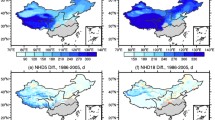Abstract
The potential effect of climate change on energy demand is important especially for the developing and non-oil-producing countries. Cooling and heating degree-day (CDD and HDD) concepts are among the most significant meteorological variables related to residential energy consumption. This paper presents the spatial and temporal characteristics of Turkish seasonal CDD and HDD in the context of climate change. CDD and HDD are defined objectively by truncation of the temperature series at any constant base temperature level. This leads to surpluses and deficits as deviations. The surpluses are instances for cooling and the deficits for heating. Depending on temperature fluctuations, the degree-day statistics at any location show local and seasonal variations. In this study, regional variations of seasonal HDD and CDD are mapped for Turkey and their relations to local topography and climatic features are examined with conclusive interpretations. The sequential version of Mann–Kendall rank statisticis applied to demonstrate any existence of possible non-linear trends in accumulated HDD and CDD over the seasons. Spatially coherent and statistically significant trends of HDD and CDD appear in some regions of Turkey. In general, the sign of the trends is inconsistent with General Circulation Models (GCM) predictions.
Similar content being viewed by others
References
Bootsma, A.: 1994, ‘Long Term (100 Yr) Climatic Trends for Agriculture at Selected Locations in Canada’, Clim. Change 26, 65–88.
Dickinson, R. E.: 1989, ‘Uncertainties of Estimates of Climatic Change: A Review’, Clim. Change 15, 5–13.
El-Shaarawi, M. A. I. and Al-Masri, N.: 1996, ‘Weather Data and Heating-Degree Days for Saudi Arabia’, Energy 21, 3944.
EPRI (Electric Power Research Institute): 1983, Weather Normalization of Electricity Sales, EPRI EA-3134, Appendix A.
Gates, D. M.: 1993, Climate Change and its Biological Consequences, Sinauer Assoc., Inc., Sunderland, MA.
Gültekin, L.: 1995, Türkiye'de Derece Günlerin Dağilimi - Distribution of Degree Days in Turkey, Unpublished Thesis, Meteorology Department, Technical University of Istanbul, p. 155.
Gültekin, M. L. and Kadioğlu, M.: 1997, Usage of Degree-Days Method in Solar Energy Potential, Turkey 7. Energy Congress 3–8 November 1997, Ankara (in Turkish).
Guttman, N. B.: 1983, ‘Variability of Population-Weighted Seasonal Heating Degree Days’, J. Appl. Meteorol. 22, 495–501.
Guttman, N. B. and Lehman, R. L.: 1992, ‘Estimation of Daily Degree-Hours’, J. Appl. Meteorol. 31, 797–810.
IPPC Working Group I: 1991, ‘Policy Makers Summary’, in Houghton, J. T., Jenkins, G. J., and Ephraums, J. J. (eds.), Climate Change: The IPCC Scientific Assessment, Cambridge University Press, Cambridge, U.K.
Jones, P. A. and Jiusto, J. E.: 1980, ‘Some Local Climate Trends in Four Cities of New York State’, J. Appl. Meteorol. 19, 135–141.
Kadioğlu, M., 1997: ‘Trends in Surface Air Temperature Data over Turkey’, Int. J. Clim. 17, 511–520.
Kadioğlu, M. and Şen, Z.: 1999, ‘Degree Day Formulations and Application in Turkey’, J. Appl. Meteorol. 38, 837–846.
Kadioğlu, M., Şen, Z., and Batur, E.: 1997, ‘The Greatest Soda-Water Lake in the World and How It Is Influenced by Climatic Change’, Ann. Geophysicae 15, 1489–1497.
Kadioğlu, M., Şen, Z., and Gültekin, L.: 1999, ‘Spatial Heating Monthly Degree-Day Features and Climatologic Patterns in Turkey’, Theor. Appl. Climatol. 64, 263–269.
Kendall, M. G. and Stuart, A.: 1966, The Advanced Theory of Statistics, Griffin, London, p. 552.
Lanchenbruch, A. H. and Marshall, B. V.: 1986, ‘Changing Climate: Geothermal Evidence from Permafrost in the Alaskan Arctic’, Science 234, 689–696.
Lenihan, J. M. and Neilson, R. P.: 1995, ‘Canadian Vegetation Sensitivity to Projected Climatic Change at Three Organizational Levels’, Clim. Change 38, 51–86.
Mitchell, J. F. B., Manabe, S., Meleshko, V., and Tokioko, T.: 1991, ‘Equilibrium Climate Change - and its Implications for the Future’, in Houghton, J. T., Jenkins, G. J., and Ephraums, J. J. (eds.), Climate Change: The IPCC Scientific Assessment, Cambridge University Press, Cambridge, U.K., pp. 131–172.
Quayle, R. G. and Diaz, H. F.: 1980, ‘Heating Degree Day Data Applied to Residential Heating Energy Consumption’, J. Appl. Meteorol. 19, 241–246.
Quirk, W. J.: 1981, ‘Climate and Energy Emergencies’, Bull. Amer. Meteorol. Soc. 62, 623–631.
Şen, Z. and Kadioğlu, M.: 1998a, ‘Heating Degree-Days for Arid Regions’, Energy 23, 1089–1094.
Şen, Z. and Kadioğlu, M.: 1998b, ‘Theoretical Risk Formulation for Degree-Day Calculations’, Theor. Appl. Climatol. 61, 121–126.
Şen, Z., Kadioğlu, M., and Koçak, K.: 1998, Comments on ‘Recent Trends in Maximum and Minimum Temperature Threshold Exceedences in the Northeastern United States’, J. Climate 11, 2147–2149.
Singh, B., Maayar, M. E., André, P., Bryant, C. R., and Thouez, J.-P.: 1998, ‘Impacts of a Ghg-Induced Climate Change on Crop Yields: Effects of Acceleration in Maturation, Moisture Stress and Optimal Temperature’, Clim. Change 38, 51–86.
Sneyers, R.: 1990, On the Statistical Analysis of Series of Observations, WMO Tech. Note 143, WMO No. 415, TP-103, Geneva, p. 192.
Solow, A. R.: 1987, ‘Testing for Climate Change: An Application of the Two-Phase Regression Model’, J. Clim. Appl. Meteorol. 26, 1401–1405.
Sykes, M. T. and Prentice, I. C.: 1996, ‘Climate Change, Tree Species Distributions and Forest Dynamics: A Case Study in the Mixed Conifer/Northern Hardwoods Zone of Northern Europe’, Clim. Change 34, 161–177.
Tegart, W. J. McG, Sheldon, G. W., and Griffiths D. C. (eds.): 1990, Climate Change: The IPCC Impacts Assessment, Cambridge University Press, Cambridge U.K.
Thom, H. S. C.: 1952, ‘Seasonal Degree Day Statistics for The United States’, Mon. Wea. Rev. 80, 143–149.
Thom, H. S. C.: 1954, ‘The Rational Relationship between Heating Degree Days and Temperature’, Mon. Wea. Rev. 82, 1–6.
Thom, H. S. C.: 1962, ‘Normal Degree Days above Any Base by The Universal Truncation Coefficient’, Mon. Wea. Rev. 94, 461–465.
Author information
Authors and Affiliations
Rights and permissions
About this article
Cite this article
Kadioğlu, M., Şen, Z. & Gültekin, L. Variations and Trends in Turkish Seasonal Heating and Cooling Degree-Days. Climatic Change 49, 209–223 (2001). https://doi.org/10.1023/A:1010637209766
Issue Date:
DOI: https://doi.org/10.1023/A:1010637209766




